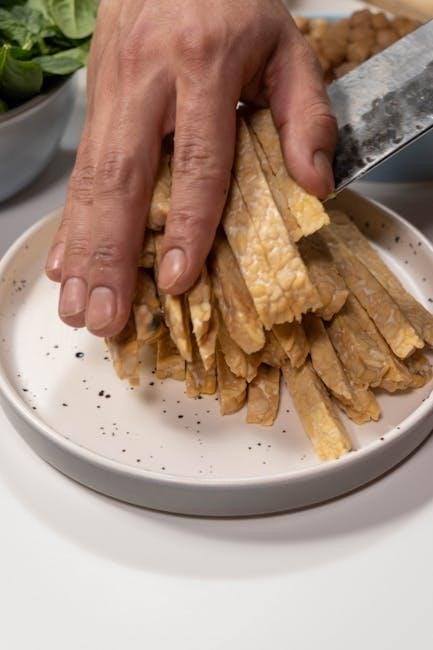
Tableau Temps de Séchage Déshydrateur PDF: A Comprehensive Guide
This comprehensive guide provides detailed insights into food dehydration, including drying times, temperature settings, and preparation tips, ensuring consistency and safety in your dehydration process.
Food dehydrating is a popular method for preserving fruits, vegetables, herbs, and meats by removing moisture, which inhibits bacterial growth and extends shelf life. This process involves controlled heat and airflow, ensuring nutrients and flavors remain intact. Dehydrating is ideal for creating healthy snacks like fruit leathers or jerky and for storing seasonal produce. While it’s a simple concept, achieving optimal results requires understanding factors like humidity, temperature, and food preparation. Air circulation is crucial, as stagnant air can slow drying. With a food dehydrator, you can efficiently manage these variables, but patience is key, as drying times can range from hours to days. This guide provides a detailed tableau of drying times, helping you master the dehydration process for consistent, high-quality results.

Factors Affecting Drying Time
Humidity, temperature, and food preparation significantly influence drying time. Higher humidity and thicker slices slow the process, while proper air circulation accelerates it.
Humidity and Environmental Conditions
Humidity plays a crucial role in drying time, as high humidity slows the evaporation of moisture from food. Check local weather conditions to determine humidity levels.
Air circulation is equally important; stagnant air retains moisture, hindering the drying process. Ensure good airflow around the dehydrator for efficient drying.
Environmental temperature also impacts drying efficiency. Higher ambient temperatures can speed up the process, but optimal results often require consistent, controlled conditions.
Monitor these factors to adjust settings and achieve the best dehydration outcomes. Proper management of humidity and airflow ensures food dries evenly and safely.
Temperature Settings
Temperature settings are critical for effective dehydration, as they directly impact drying time and food safety. Most dehydrators operate between 50°C and 70°C, with lower temperatures preserving nutrients and higher temperatures speeding up the process.
Specific foods require precise temperatures: fruits like strawberries and bananas typically dry at 50-60°C, while herbs and spices may need slightly higher temperatures, around 60-70°C. Meat and fish often require higher settings.

It’s essential to maintain consistent temperatures throughout the drying process to ensure even results. Refer to your dehydrator’s guidelines for optimal settings, as variations can affect both quality and safety.
Food Preparation Methods
Proper food preparation is essential for successful dehydration. Start by washing and cleaning the food thoroughly to remove dirt and bacteria. Fruits and vegetables should be sliced evenly to ensure consistent drying. Uniform thickness prevents some pieces from over-drying while others remain moist. For meats and fish, trimming excess fat and cutting into thin strips is recommended. Herbs can be dried whole or chopped, depending on preference. Blanching vegetables before dehydration can help retain color and nutrients, while pre-soaking fruits like apricots and raisins can reduce drying time. Peel tough skins and remove seeds or pits to enhance texture and flavor. Proper preparation ensures food dries evenly and retains its quality, making it safe and enjoyable for consumption. Always follow food safety guidelines to avoid contamination.

Drying Time Table for Common Foods
This section provides a detailed chart outlining the recommended drying times for popular foods like fruits, vegetables, meats, and herbs, ensuring precise dehydration results.
Fruits
Fruits are a popular choice for dehydration due to their natural sweetness and versatility. Common fruits like apples, bananas, and strawberries typically require 6-12 hours at 50-60°C. Thicker slices may need up to 24 hours, while thinner slices dry faster. Berries like strawberries and blueberries dry quickly, often within 8-12 hours at 45-50°C. Tropical fruits such as pineapple and mango may take 12-18 hours at 50-60°C. Figs, when cut in half, generally dry in 40-60 hours at 50°C. Proper preparation, such as peeling and slicing, ensures even drying. Monitoring fruit for chewiness or crispiness helps achieve the desired texture. Always refer to the full table for precise times and temperatures based on your dehydrator model and fruit type.
Vegetables
Vegetables vary in drying times depending on their thickness and water content. Spinach and herbs like parsley typically dry in 12-16 hours at 42°C, while thicker vegetables like zucchini or carrots may require 8-12 hours at 50-60°C. Tomatoes, when halved and deseeded, dry in 24-48 hours at 45°C. Garlic slices, at 5mm thickness, take around 12-16 hours at 50°C. Onions, sliced at 3-5mm, dry in 12-16 hours at 50°C. Bell peppers, sliced or halved, require 12-18 hours at 50-60°C. Proper preparation, such as peeling and slicing, ensures uniform drying. Monitoring vegetables for crispiness or flexibility is key. Always consult the detailed table for specific times and temperatures tailored to your dehydrator model and vegetable type to achieve optimal results.
Herbs and Spices
Herbs and spices can be dried efficiently using a food dehydrator, with times varying based on their moisture content and desired texture. Leafy herbs like parsley and basil typically dry in 6-12 hours at 35-40°C, while thicker herbs like rosemary may require 8-12 hours. Whole herb leaves generally take longer than crushed or ground forms. Spices like garlic, when sliced into 5mm thickness, dry in 12-16 hours at 50°C. Proper air circulation is essential to prevent mold growth. Store dried herbs in airtight containers to preserve freshness. Always refer to the detailed table for specific times and temperatures, ensuring optimal drying for each herb and spice type. This guide provides precise recommendations for achieving perfectly dried herbs and spices every time.
Meat and Fish
Drying meat and fish requires careful attention to temperature and thickness to ensure food safety and quality. Thinly sliced meats like beef or turkey typically dry at 50°C for 3-6 hours, while thicker cuts may require up to 8 hours. Fish, such as salmon or cod, should be dried at a lower temperature of 38°C for 6-8 hours to prevent over-drying. Marinating meats before dehydration enhances flavor and tenderizes the texture. For fish, patting dry with paper towels before dehydrating helps remove excess moisture. Always ensure the meat reaches a safe dryness level to avoid spoilage. Refer to the detailed drying time table for specific guidelines, ensuring optimal results for various types of meat and fish. Proper storage in airtight containers is crucial to maintain freshness and texture.

How to Use a Food Dehydrator
Prep food by washing, slicing, and seasoning. Place evenly on trays, set the temperature, and let the dehydrator run. Monitor progress periodically for optimal results.
Step-by-Step Preparation Guide
Start by washing and cleaning the food thoroughly. Slice fruits, vegetables, and meats evenly to ensure uniform drying. Pat dry excess moisture with a clean cloth. Season or marinate if desired, but avoid oil-based marinades. Arrange food in a single layer on dehydrator trays, leaving space for air circulation. Set the temperature according to the food type, typically between 45°C to 65°C. Allow the dehydrator to run for the recommended time, monitoring progress after 4-6 hours. Flip or rotate trays for even drying if needed. Once dry, let cool before storing in airtight containers. Always refer to the tableau temps de séchage déshydrateur PDF for precise guidance.

Setting the Right Temperature
Temperature is a critical factor in food dehydration. Most foods require a temperature range of 45°C to 65°C to ensure safe and effective drying. Lower temperatures preserve nutrients and colors, while higher settings speed up the process. For delicate items like herbs, use 45°C to prevent loss of flavor and aroma. Fruits typically dry well at 50°C to 55°C, while vegetables may require 55°C to 60°C. Meats and fish need higher temperatures, around 60°C to 65°C, to ensure food safety. Always refer to the tableau temps de séchage déshydrateur PDF for specific temperature guidelines tailored to your food type. Adjusting the temperature correctly balances quality, safety, and drying efficiency.
Monitoring the Drying Process
Monitoring the drying process is essential to ensure optimal results. Check the food periodically to avoid over-drying, especially during the final hours. Use the tableau temps de séchage déshydrateur PDF as a reference, but adjust based on your dehydrator’s performance. Rotate trays if necessary to ensure even drying. For fruits and vegetables, check for a leathery texture, while herbs should crumble easily. Meat and fish should feel dry and firm. Avoid opening the dehydrator too frequently, as this can release heat. Use the built-in timer or a separate timer to keep track of drying times. Proper monitoring ensures food is dry yet retains its quality and nutrients. This step is crucial for achieving the best results in food dehydration.

Best Practices for Dehydration
Uniform slicing, proper air circulation, and consistent monitoring ensure even drying. Store dehydrated foods in airtight containers to maintain freshness and prevent moisture absorption.
Thickness of Slices
The thickness of slices plays a crucial role in achieving consistent dehydration results. Uniform slices ensure even drying, preventing some parts from becoming over-dried while others remain moist. For most fruits and vegetables, slices should be between 5-10 mm thick, depending on the food’s texture and water content. Herbs and delicate items like spinach can be left whole or chopped finely, while meats should be sliced thinly to avoid long drying times. Using a mandoline slicer or sharp knife helps maintain uniformity. Inconsistent thickness can lead to uneven drying, affecting the final quality. Always refer to your dehydration guide for specific thickness recommendations tailored to your food type and desired outcome. Proper slicing is the first step toward successful dehydration and long-term food preservation.
- Uniform slices ensure even drying.
- Recommended thickness: 5-10 mm for most foods.
- Herbs and delicate greens can be whole or finely chopped.
- Meats should be sliced thinly for optimal results.
Air Circulation Tips
Air circulation is vital for efficient dehydration, as it ensures moisture is evenly removed from food. Proper airflow prevents the accumulation of steam, which can lead to uneven drying or mold growth. To enhance circulation, avoid overcrowding trays—leave space between slices for air to flow freely. Rotate trays halfway through the drying process to ensure uniform results. For leafy greens and herbs, a single layer is ideal. Regularly cleaning your dehydrator’s vents and filters also maintains optimal airflow. Additionally, placing the dehydrator in a well-ventilated area prevents moisture buildup in the room. By prioritizing airflow, you achieve faster, more consistent drying and higher-quality preserved foods.
- Leave space between food slices for proper airflow.
- Rotate trays for even drying.
- Avoid overcrowding to prevent steam buildup.
- Keep vents and filters clean for optimal performance.
Storage After Drying
Proper storage is essential to maintain the quality and shelf life of dehydrated foods. Store dried foods in airtight containers to protect them from moisture, light, and pests. Glass jars with tight-fitting lids or vacuum-sealed bags are ideal. Keep containers in a cool, dark place to preserve flavor and nutrients. Avoid exposure to direct sunlight, as it can cause degradation. For long-term storage, consider using desiccants or silica gel packets to absorb any residual moisture. Label containers with the date and contents for easy identification. Regularly check stored foods for signs of moisture or spoilage. Properly stored dehydrated foods can last for months, retaining their nutritional value and flavor.
- Use airtight containers like glass jars or vacuum-sealed bags.
- Store in a cool, dark place to preserve quality.
- Avoid direct sunlight and moisture exposure.
- Label containers with date and contents.
- Check periodically for spoilage or moisture.

Advanced Dehydration Techniques
Master advanced dehydration by combining foods for balanced flavor, optimizing tray arrangement, and fine-tuning temperature and timing for consistent, professional-grade results.
- Combine fruits and vegetables to enhance flavor profiles.
- Arrange foods strategically for even airflow and drying.
- Adjust settings based on food type and desired texture.
Combining Foods for Optimal Drying
Combining foods in a dehydrator can enhance flavor profiles and textures, creating balanced results. Start by pairing fruits with herbs or spices, such as strawberries with mint or apples with cinnamon, for unique snacks. Vegetables like zucchini and bell peppers can be mixed for variety. Ensure foods have similar drying times to avoid under- or over-drying. Monitor the process, as denser foods may require longer durations. For meats, blend seasonings or herbs for added flavor. Experiment with marinades or spices before dehydration for richer tastes. Keep track of combinations and their outcomes to refine future batches. This technique not only diversifies your creations but also maximizes efficiency in the dehydration process. Always maintain proper hygiene and storage practices to preserve quality and safety.
Using Trays Efficiently
Maximizing tray space is key to efficient dehydration. Arrange food in a single layer, leaving enough space for air to circulate, ensuring even drying. Avoid overcrowding, as this can lead to uneven results or longer drying times. For optimal use, group foods with similar drying times or textures on the same tray. Herbs and thin vegetable slices, for example, can share a tray, while thicker foods like meat or fruit should be separated. Rotate trays halfway through the cycle to ensure consistent drying, especially in dehydrators with variable air circulation. Monitor food as it dries, removing items that are ready while allowing others to continue. This method prevents over-drying and makes the most of your dehydrator’s capacity. Proper tray management enhances efficiency and overall dehydration success.
Maintaining Consistency in Results
Achieving consistent dehydration results requires careful attention to preparation, temperature, and monitoring. Uniform slice thickness ensures even drying, while precise temperature settings prevent under- or over-drying. Humidity levels and air circulation also play a role; higher humidity can slow the process, so adjust settings accordingly. Regularly check food during dehydration to avoid over-drying, especially for delicate items like herbs. Use a timer and keep a log of drying times for specific foods to refine future sessions. Consistency is key to producing high-quality, shelf-stable results. By following guidelines and adapting to your environment, you can achieve reliable outcomes every time, ensuring your dehydrated foods retain their flavor, texture, and nutritional value.

Troubleshooting Common Issues
Address common dehydration challenges like over-drying, under-drying, and uneven results by adjusting settings, monitoring progress, and ensuring proper air circulation. Regular checks and humidity adjustments help maintain consistency.
Over-Drying and Under-Drying
Over-drying occurs when food becomes too brittle or develops an unpleasant texture, often due to excessive temperature or time. Under-drying, conversely, leaves food with residual moisture, risking mold growth. Both issues stem from improper monitoring or miscalibrated settings. Environmental humidity and food thickness play significant roles; thicker slices retain moisture longer, while high humidity slows drying. Prevent over-drying by checking food regularly, especially near the end of the estimated drying time. For under-drying, ensure even air circulation and avoid overcrowding trays. Adjusting temperature and duration based on food consistency can help achieve the perfect dryness. Regular monitoring is crucial to prevent these common pitfalls and ensure safe, high-quality dehydration results. Proper preparation and adherence to guidelines minimize the risk of over-dried or under-dried foods, enhancing both flavor and shelf life.
Uneven Drying Patterns
Uneven drying patterns occur when some areas of food dry faster than others, leading to inconsistent texture and quality. This issue often arises due to poor air circulation, overcrowded trays, or improper food placement. Foods near the dehydrator’s heat source may dry quicker, while those farther away remain moist. To address this, ensure adequate spacing between food slices and rotate trays midway through the drying process. Using uniform slice thickness and avoiding overlapping pieces also helps. Regularly monitoring the drying progress and rearranging food as needed can mitigate uneven drying. Additionally, maintaining consistent room humidity and following recommended temperature guidelines further promote uniform results. Addressing these factors ensures all food dries evenly, preserving texture and flavor while preventing spoilage risks. Proper tray arrangement and airflow management are key to achieving consistently dried outcomes.
Dealing with High Humidity
High humidity significantly slows down the dehydration process, as moisture in the air hinders the food’s ability to dry evenly. This can lead to prolonged drying times and an increased risk of mold or spoilage. To combat high humidity, ensure your dehydrator is placed in a well-ventilated area, preferably away from direct sunlight or moisture sources. Increasing the temperature slightly, within safe food guidelines, can help counteract the effects of humidity. Regularly monitoring the food’s moisture levels and adjusting the drying time as needed is crucial. Additionally, storing dried foods promptly in airtight containers can prevent reabsorption of moisture. Always refer to your dehydrator’s guidelines for optimal settings in humid conditions to achieve the best results and maintain food safety. Proper management of humidity ensures efficient and successful dehydration outcomes.

Health and Safety Considerations
Ensure food safety by following proper hygiene practices, storing dried foods in airtight containers, and maintaining consistent dehydration temperatures to prevent contamination and spoilage risks.
Food Safety Guidelines
Ensuring food safety is crucial when dehydrating foods. Always wash hands thoroughly before handling food and clean the dehydrator trays with sanitized solutions. Use a food thermometer to monitor temperatures accurately, as improper heating can lead to contamination. Store dehydrated foods in airtight, moisture-proof containers to prevent rehydration and mold growth. Avoid cross-contamination by separating raw and dried foods. Regularly inspect dried foods for signs of spoilage, such as mold or an off smell. Follow recommended dehydration times and temperatures to eliminate harmful bacteria. Properly label and date stored foods for traceability. By adhering to these guidelines, you can enjoy safe, healthy, and nutritious dehydrated meals year-round.
Hygiene Practices
Proper hygiene is essential when using a food dehydrator to ensure clean and safe dehydration. Wash your hands thoroughly with soap and water before handling food or the dehydrator. Clean the dehydrator trays and surfaces with a mild detergent and warm water after each use to prevent residue buildup. Sanitize utensils and cutting tools with a food-safe sanitizer to avoid cross-contamination. Regularly wipe down the exterior of the dehydrator to remove dust and splatters. Always rinse fruits, vegetables, and meats under clean running water before slicing or placing them on the trays. Avoid touching food unnecessarily during preparation to minimize contamination risk. By maintaining strict hygiene practices, you can ensure a clean and efficient dehydration process.
Storage and Shelf Life
Proper storage is crucial to maintain the quality and shelf life of dehydrated foods. Store dried foods in airtight containers, such as glass jars or vacuum-sealed bags, to protect them from moisture, air, and pests. Keep containers in a cool, dark place to prevent degradation from light and heat. Moisture can quickly ruin dried foods, so ensure containers are completely dry before use. Label containers with the date and contents for easy tracking. Most dehydrated foods can be stored for 6-12 months at room temperature, but some, like herbs, may last longer. For longer storage, consider refrigerating or freezing, especially for high-fat foods like meats, to prevent rancidity. Always check for signs of spoilage, such as mold or off odors, before consuming.
Mastering food dehydration ensures consistent results, allowing you to preserve nutrients and flavors while exploring new recipes. Keep experimenting and maintain a log for future reference.
Final Tips for Successful Dehydration
To achieve optimal dehydration results, always monitor your food’s texture and color. Adjust temperature and time based on your food’s moisture content and thickness. Maintain consistency by slicing ingredients uniformly and ensuring proper air circulation. Keep a dehydration log to track your progress and refine techniques over time. Experiment with seasoning or marinades before drying to enhance flavors. Store dried foods in airtight containers to preserve freshness and prevent rehydration. Regularly clean your dehydrator to avoid contamination and ensure efficient performance. Finally, stay patient and observant, as dehydration is a process that requires attention to detail for the best outcomes. Happy dehydrating!
Encouragement for Further Exploration
Dehydration is a versatile and rewarding process that opens doors to creative meal planning and sustainable food preservation. With the insights from this guide, you’re well-equipped to experiment with new recipes and techniques. Explore the endless possibilities of drying fruits, vegetables, meats, and herbs, and discover how dehydration can enhance flavors and textures. Dive into advanced methods like combining foods for optimal drying or mastering the use of dehydrator trays. Share your experiences and learn from others in the dehydration community. Remember, practice makes perfect—keep experimenting and refining your skills. The journey of dehydration is not only practical but also creatively fulfilling, offering countless opportunities to innovate and enjoy wholesome, nutritious foods year-round. Embrace the adventure and happy dehydrating!